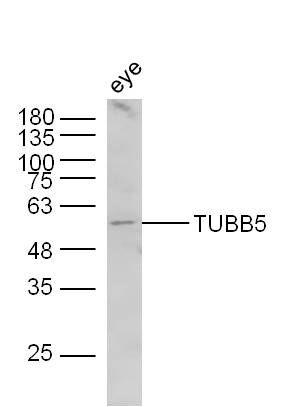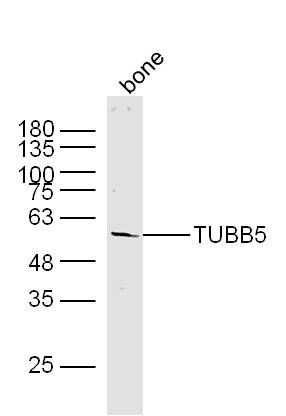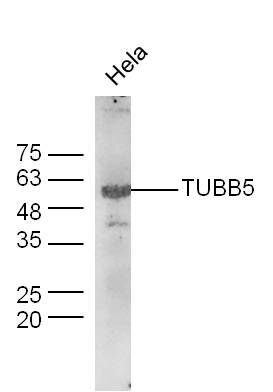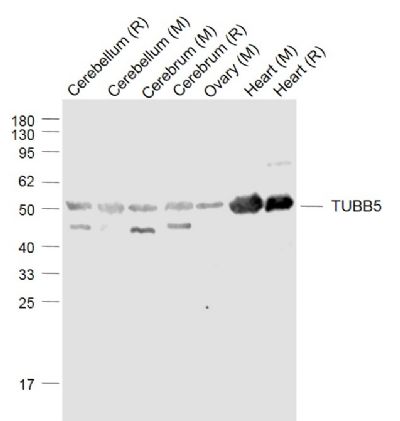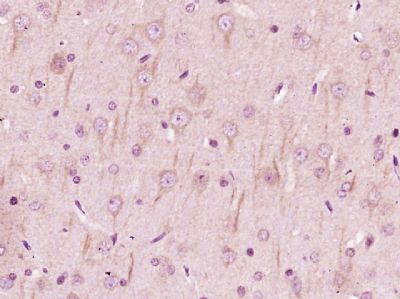This gene encodes a beta tubulin protein. This protein forms a dimer with alpha tubulin and acts as a structural component of microtubules. Mutations in this gene cause cortical dysplasia, complex, with other brain malformations 6. Alternative splicing results in multiple splice variants. There are multiple pseudogenes for this gene on chromosomes 1, 6, 7, 8, 9, and 13. [provided by RefSeq, Jun 2014]
Function:
Tubulin is the major constituent of microtubules. It binds two moles of GTP, one at an exchangeable site on the beta chain and one at a non-exchangeable site on the alpha chain.
Subunit:
Dimer of alpha and beta chains. May interact with RNABP10. Interacts with PIFO. Interacts with MX1.
Subcellular Location:
Cytoplasmic, cytoskeleton.
Tissue Specificity:
Ubiquitously expressed with highest levels in spleen, thymus and immature brain.
Post-translational modifications:
Some glutamate residues at the SLCterminus are polyglutamylated. This modification occurs exclusively on glutamate residues and results in polyglutamate chains on the gamma-carboxyl group. Also monoglycylated but not polyglycylated due to the absence of functional TTLL10 in human. Monoglycylation is mainly limited to tubulin incorporated into axonemes (cilia and flagella) whereas glutamylation is prevalent in neuronal cells, centrioles, axonemes, and the mitotic spindle. Both modifications can coexist on the same protein on adjacent residues, and lowering glycylation levels increases polyglutamylation, and reciprocally. The precise function of such modifications is still unclear but they regulate the assembly and dynamics of axonemal microtubules (Probable).
Similarity:
Belongs to the tubulin family.
SWISS:
P07437
Gene ID:
203068
Database links:
Entrez Gene: 203068 Human
Entrez Gene: 22154 Mouse
Entrez Gene: 29214 Rat
Omim: 191130 Human
SwissProt: P07437 Human
SwissProt: P99024 Mouse
SwissProt: P69897 Rat
Unigene: 63696 Human
Unigene: 2458 Rat
| Picture |
Sample: Eye (mouse) Lysate at 40 ug
Primary: Anti- TUBB5 (SL12863R) at 1/300 dilution
Secondary: IRDye800CW Goat Anti-Rabbit IgG at 1/20000 dilution
Predicted band size: 50 kD
Observed band size: 55 kD
Sample: Bone (mouse) Lysate at 40 ug
Primary: Anti- TUBB5 (SL12863R) at 1/300 dilution
Secondary: IRDye800CW Goat Anti-Rabbit IgG at 1/20000 dilution
Predicted band size: 55 kD
Observed band size: 55 kD
Sample: hela (human)cell Lysate at 40 ug
Primary: Anti- TUBB5(SL12863R) at 1/300 dilution
Secondary: IRDye800CW Goat Anti-Rabbit IgG at 1/20000 dilution
Predicted band size: 55 kD
Observed band size: 55 kD
Sample:
Lane 1: Cerebellum (Rat) Lysate at 40 ug
Lane 2: Cerebellum (Mouse) Lysate at 40 ug
Lane 3: Cerebrum (Mouse) Lysate at 40 ug
Lane 4: Cerebrum (Rat) Lysate at 40 ug
Lane 5: Ovary (Mouse) Lysate at 40 ug
Lane 6: Heart (Mouse) Lysate at 40 ug
Lane 7: Heart (Rat) Lysate at 40 ug
Primary: Anti-TUBB5 (SL12863R) at 1/1000 dilution
Secondary: IRDye800CW Goat Anti-Rabbit IgG at 1/20000 dilution
Predicted band size: 50 kD
Observed band size: 50 kD
Paraformaldehyde-fixed, paraffin embedded (Rat brain); Antigen retrieval by boiling in sodium citrate buffer (pH6.0) for 15min; Block endogenous peroxidase by 3% hydrogen peroxide for 20 minutes; Blocking buffer (normal goat serum) at 37°C for 30min; Antibody incubation with (TUBB5) Polyclonal Antibody, Unconjugated (SL12863R) at 1:400 overnight at 4°C, followed by operating according to SP Kit(Rabbit) (sp-0023) instructions and DAB staining.
|
|
|
